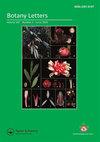Chemical diversity of floral scents in 9 species of Philodendron (Araceae) from French Guiana
IF 1.3
4区 生物学
Q3 PLANT SCIENCES
引用次数: 1
Abstract
ABSTRACT We provide a characterization of the floral scent chemistry of nine species of Philodendron present in French Guiana. The scent samples were obtained by dynamic headspace, in situ in French Guiana, or from plants in the living aroid collection at the Botanical Garden of the University of Brasilia. Overall, we identified 43 volatile organic compounds (VOCs) belonging to the compound classes of monoterpenes, sesquiterpenes, irregular terpenes, benzenoids, aliphatics, jasmone derivatives, and nitrogen-containing compounds. Five of these floral VOCs are new reports for Philodendron. Interestingly, the floral blends in the investigated species were comprised of 3–22 VOCs; but when considering only major VOCs (≥5%), each fragrant blend could be summarized into one up to four constituents. Except for P. acutatum and P. billietiae, whose floral scents were largely dominated (≥93%) by 4-vinylanisole, fragrances of the investigated species were dominated (≥62%) each by a different VOC (i.e. dehydrojasmone, dihydro-β-ionone, (E)-4,8-dimethylnona-1,3,7-trien-5-yl acetate, methyl benzoate, 1,3,5-trimethoxybenzene, dihydrobovolide, or (Z)-jasmone). Consequently, all floral scent compositions significantly differed from one other. We compare our results to published data to provide an insight into the floral scent chemistry within the genus Philodendron. We further discuss the diversity of VOCs in cyclocephaline scarab-pollinated aroids.法属圭亚那9种天南星属植物花香化学多样性研究
摘要:我们对法属圭亚那九种杜鹃花的花香化学成分进行了表征。气味样本是通过动态顶空法在法属圭亚那原位获得的,或者是从巴西利亚大学植物园的活体芳香族植物中获得的。总体而言,我们鉴定了43种挥发性有机化合物(VOC),属于单萜、倍半萜、不规则萜、苯类、脂肪族、茉莉酮衍生物和含氮化合物的化合物类别。其中五种挥发性有机化合物是杜鹃花的新报告。有趣的是,研究物种中的花卉混合物由3–22种挥发性有机物组成;但当仅考虑主要的挥发性有机物(≥5%)时,每种芳香混合物可以概括为一种最多四种成分。除了尖尖霉和billietiae的花香主要由4-乙烯基苯甲醚主导(≥93%)外,所研究物种的香味均由不同的VOC主导(≥62%)(即脱氢茉莉酮、二氢-β-紫罗兰酮、(e)-4,8-二甲基壬-1,3,7-三烯-5-基乙酸酯、苯甲酸甲酯、1,3,5-三甲氧基苯、二氢牛内酯或(Z)-茉莉酮)。因此,所有花香成分彼此之间存在显著差异。我们将我们的结果与已发表的数据进行了比较,以深入了解杜鹃属的花香化学。我们进一步讨论了环头金龟子授粉的aroids中挥发性有机物的多样性。
本文章由计算机程序翻译,如有差异,请以英文原文为准。
求助全文
约1分钟内获得全文
求助全文
来源期刊

Botany Letters
Agricultural and Biological Sciences-Plant Science
CiteScore
3.10
自引率
6.70%
发文量
54
期刊介绍:
Botany Letters is an international scientific journal, published by the French Botanical Society (Société botanique de France) in partnership with Taylor & Francis. Botany Letters replaces Acta Botanica Gallica, which was created in 1993, building on over a century of renowned publications by the Société botanique de France.
 求助内容:
求助内容: 应助结果提醒方式:
应助结果提醒方式:


